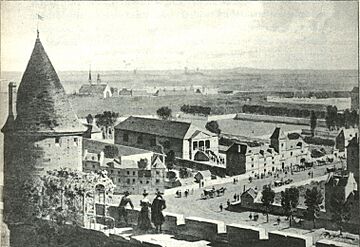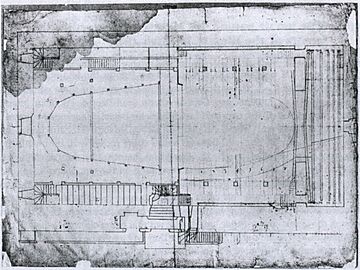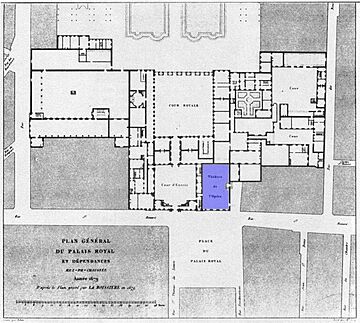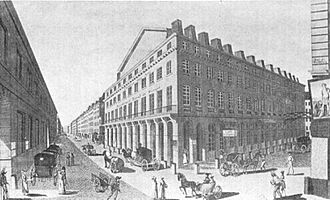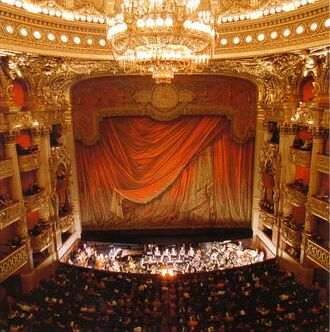Paris Opera facts for kids
|
Opéra national de Paris
|
|
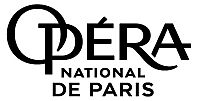
Logo of the Paris Opera
|
|
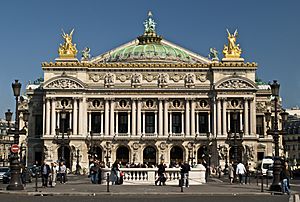
Palais Garnier
|
|
| Type | Opera and ballet company |
|---|---|
| Location |
|
| Website | operadeparis.fr |
The Paris Opera is France's main company for opera and ballet. It started in 1669, founded by Louis XIV, the King of France. It was first called the Académie d'Opéra. Later, it was led by Jean-Baptiste Lully and renamed the Académie Royale de Musique. People often just called it the Opéra.
Today, it's known as the Opéra national de Paris. It mostly performs operas at the Opéra Bastille, a modern theater that opened in 1989. This theater can hold 2,723 people. Ballets and some classic operas are shown at the older Palais Garnier, which opened in 1875 and has 1,979 seats. Smaller and newer shows are also performed in a 500-seat area under the Opéra Bastille.
The Paris Opera has a big budget, with money from the French government and ticket sales. This helps them run their two theaters and pay a large team. This team includes an orchestra with 170 musicians, a chorus with 110 singers, and a ballet company with 150 dancers.
Every year, the Paris Opera puts on about 380 performances. These include operas, ballets, and concerts. Around 800,000 people attend these shows each year. About 17% of the audience comes from other countries. The theaters are usually very full, with about 94% of seats taken.
Contents
History of the Paris Opera
The Paris Opera has a long and interesting history, changing names and locations many times.
How the Opera Began
Pierre Perrin's Idea
A poet named Pierre Perrin first thought about creating French opera in 1655. This was more than ten years before the Paris Opera officially started. He believed that the French language could be used beautifully in music, even though many people at the time disagreed.
In 1666, Perrin suggested to King Louis XIV's minister, Jean-Baptiste Colbert, that the king should create an "Academy of Poetry and Music." The goal was to combine French language and music into a new type of musical theater.
On June 28, 1669, King Louis XIV signed a special document for Perrin. This document gave Perrin the only right for 12 years to open opera academies anywhere in France. These academies would perform operas in French. Perrin could choose his business partners and set ticket prices. No one, not even members of the royal family, could get in for free. Also, no one else could start a similar opera company. This special right helped protect the new opera company as it was just starting.
Perrin turned a building used for tennis, called the Bouteille tennis court, into a theater. It had space for stage machinery and scenery and could hold about 1200 people.
Jean-Baptiste Lully Takes Over
The opera company was renamed the Académie Royale de Musique. People in France simply called it the Opéra. Soon after, Jean-Baptiste Lully, a famous composer, convinced the king to give him even more control. Lully made it harder for other French and Italian theater groups to use many singers or musicians.
Because of some legal issues, Lully could not use the Bouteille theater. So, a new theater was built for him at the Salle du Bel-Air, another tennis court. Later, Lully also allowed other cities like Marseille, Lyon, and Bordeaux to open their own music academies. During Lully's time, only his own works were performed. His first productions were a pastoral show called Les fêtes de l'Amour et de Bacchus in 1672 and his first opera, Cadmus et Hermione, in 1673.
After the playwright Molière died in 1673, his theater group moved. This meant the theater at the Palais-Royal, which had been built by Cardinal Richelieu, became available. This theater was a good size for sound, unlike some much larger ones. Lully really wanted a better theater and convinced the king to let him use the Palais-Royal theater for free. The theater was updated in 1674.
The first show in the new Palais-Royal theater was Alceste in 1674. Some people were angry because Lully had placed so many rules on other theater groups. To help, King Louis XIV arranged for new operas to be shown first at the royal court. This helped pay for rehearsals, sets, and costumes, which were then given to the Paris Opera for use in Paris. During Lully's time, performances happened all year, except for three weeks around Easter. New shows usually premiered during the Carnival season and then moved to Paris after Easter. About two or three new works were performed each year.
After Lully's Time
After Lully passed away in 1687, the number of new shows each year almost doubled. This was because the new composers found it harder to keep the audience interested. Old works by Lully were often brought back. French composers usually wrote music for new stories, which had to be approved by the opera directors. It was not common in Paris to create new music for old stories until around 1760. An important new work from this time was an opera-ballet called L'Europe galante by André Campra, shown in 1697.
The Rise of Ballet
In 1661, King Louis XIV, who loved to dance, created the Académie Royale de Danse. This academy was meant to set rules for court dances and train dance teachers. From 1680 until Lully's death, it was led by Pierre Beauchamp, who created the five positions of the feet used in ballet today.
When Lully took over the Opéra in 1672, he and Beauchamp made theatrical ballet a very important part of the company's shows. At that time, ballet was mostly a part of the opera, not a separate art form. But as it grew more important, the dance group became known as the Paris Opera Ballet. In 1713, a ballet school was opened, which is now the Paris Opera Ballet School.
The Opera in the 1800s
During the French Revolution, the company changed its name many times. It stopped using names linked to the royal family. In 1794, it moved to the Théâtre National de la rue de la Loi and was called the Théâtre des Arts.
Napoleon took control of the company in 1802. When he created the French Empire in 1804, he renamed the company the Académie Impériale de Musique. After the monarchy returned in 1814, it was again called the Académie Royale de Musique. In 1821, the company moved to the Salle Le Peletier, which could hold 1900 people. It stayed there until the building was destroyed by fire in 1873.
In the second half of the 1800s, when Napoleon III came to power, the name Académie Impériale de Musique was used again. After 1870, with the start of the Third Republic, it changed to Théâtre National de l'Opéra. In 1875, the company moved into its grand new home, the Palais Garnier.
The Opera in the 1900s
Between 1908 and 1914, Henri Benjamin Rabaud conducted at the Palais Garnier. He also wrote several works that were first shown at the Opéra-Comique but later performed at the Palais Garnier.
In 1939, the Opéra joined with another company, the Opéra-Comique. The new name was Réunion des Théâtres Lyriques Nationaux. The Opéra-Comique closed in 1972 but was reopened in 1976.
In 1990, the Opéra moved its main performances to the new Opéra Bastille. It became known as the Opéra de Paris. However, it still put on shows, especially ballets, at the Palais Garnier. The Opéra-Comique also became independent again. In 1994, the Opéra de Paris became the Opéra National de Paris. Even with all these name changes, people usually just called the company and its theaters "the Opéra."
The Opera Today (21st Century)
The current managing director of the Opéra is Alexander Neef, who started in September 2020. Famous music directors in the past include Myung-whun Chung and Philippe Jordan. In April 2021, the Opéra announced that Gustavo Dudamel would be its next music director, starting August 1, 2021. However, in May 2023, Dudamel announced he would leave the role in August 2023.
Watching Shows Online
On April 7, 2023, the Paris Opera launched its own online video service called Paris Opera Play (or POP). When it first started, it had 80 different shows. These included videos of operas, ballets, documentaries, and special classes. People who subscribe can also watch live performances.
You can watch these videos using a web browser like Google Chrome, Firefox, Microsoft Edge, or Safari. Most videos have subtitles in French and English. If you want to watch on a TV, you can use Chromecast or AirPlay. However, AirPlay does not show subtitles. A good way to watch with subtitles on a TV is to connect your computer to the TV with an HDMI cable. In March 2025, it was announced that Paris Opera Play also became available as apps for Apple TV and Android TV.
Images for kids
-
The Opéra Bastille inside
Official Names of the Company
The Paris Opera has had many different official names throughout its history. Here are some of them:
| Date | Official name | Notes |
|---|---|---|
| June 28, 1669 | Académie d'Opéra | Pierre Perrin received permission from Louis XIV. |
| March 13, 1672 | Académie Royale de Musique | Jean-Baptiste Lully received permission from Louis XIV. |
| June 24, 1791 | Opéra | After Louis XVI left Paris. |
| August 7, 1794 | Théâtre des Arts | The Opéra moved to the Théâtre National de la rue de la Loi. |
| June 29, 1804 | Académie Impériale de Musique | When Napoleon Bonaparte started the First French Empire. |
| July 9, 1815 | Académie Royale de Musique | After the monarchy was restored. |
| September 4, 1870 | Théâtre de l'Opéra | With the start of the French Third Republic. |
| January 14, 1939 | Réunion des Théâtres Lyriques Nationaux | The Opéra took control of the Opéra-Comique. |
| April 2, 1990 | Opéra de Paris | Moved to the Opéra Bastille; Opéra-Comique became independent again. |
| February 5, 1994 | Opéra National de Paris | The current official name. |
Main Theaters Used by the Paris Opera
The Paris Opera has performed in many different buildings over the centuries. Here are some of its most important venues:
| Theatre | Dates used | Notes |
|---|---|---|
| Salle de la Bouteille | March 3, 1671 – April 1, 1672 | Located on the Rue Mazarine; later torn down. |
| Salle du Bel-Air | November 10, 1672 – June 1673 | Also called Jeu de Paume de Béquet; later torn down. |
| Salle du Palais-Royal (1st) | June 16, 1673 – April 6, 1763 | Built in 1641; destroyed by fire in 1763. |
| Théâtre National de la rue de la Loi | July 26, 1794 – February 13, 1820 | This theater was later torn down. |
| Salle Le Peletier | August 16, 1821 – October 28, 1873 | Built as a temporary home; destroyed by fire in 1873. |
| Palais Garnier | January 5, 1875 – June 29, 1936 | Designed by Charles Garnier; a very famous building. |
| Palais Garnier | February 21, 1937 – present | Reopened after being renovated. |
| Opéra Bastille | July 13, 1989 – present | Designed by Carlos Ott; opened to celebrate the 200th anniversary of the French Revolution. |
Leaders of the Paris Opera
Many people have managed the Paris Opera throughout its long history. Here are some of the key leaders:
| Start date | Name | Administration |
|---|---|---|
| June 28, 1669 | Pierre Perrin | Royal Household |
| March 30, 1672 | Jean-Baptiste Lully | |
| August 25, 1749 | Louis-Basile de Bernage, Marquis d'Argenson, then François Rebel and François Francœur | City of Paris |
| March 13, 1757 | François Rebel, François Francœur | Royal Household |
| April 18, 1776 | Royal Commissioners | Royal Commissioners |
| March 2, 1831 | Louis-Désiré Véron | Private business with government help |
| July 1, 1854 | Nestor Roqueplan | Imperial Household |
| December 20, 1862 | Émile Perrin | |
| January 1, 1908 | Leimistin Broussan, André Messager | |
| January 1, 1915 | Jacques Rouché | |
| January 14, 1939 | Government administration | |
| January 1, 1972 | Rolf Liebermann | (Opéra-Comique closed) |
| September 1, 2020 | Alexander Neef |
Other Opera Companies and Theaters in Paris
For a long time, from 1725 to 1791, there were only four main public theaters allowed in Paris:
- Opéra de Paris
- Comédie-Française
- Comédie-Italienne
- Opéra-Comique
In 1762, the Opéra-Comique joined with the Comédie-Italienne.
After 1791, laws changed, allowing almost anyone to open a public theater. This led to many new theaters and companies. Some of these new theaters included:
- Théâtre Feydeau
- Théâtre Italien
- Théâtre Lyrique
- Théâtre de l'Ambigu-Comique
- Théâtre des Bouffes-Parisiens
- Cirque Olympique
- Théâtre de la Gaîté
- Gymnase-Dramatique
- Théâtre des Nouveautés
- Théâtre de l'Odeon
- Porte-St-Martin
- Théâtre de la Renaissance
- Théâtre des Variétés
- Théâtre du Vaudeville
After about 1870, the opera scene in Paris was simpler, mainly with the Opéra and the Opéra-Comique.
See also
 In Spanish: Ópera de París para niños
In Spanish: Ópera de París para niños
- List of theatres and entertainment venues in Paris
- Opéra (Paris Métro)
- The Phantom of the Opera


